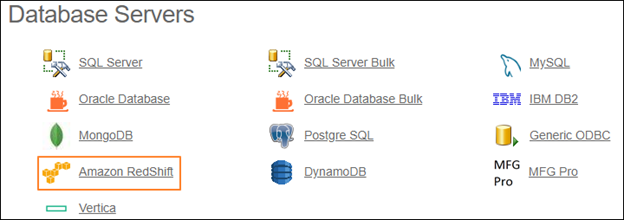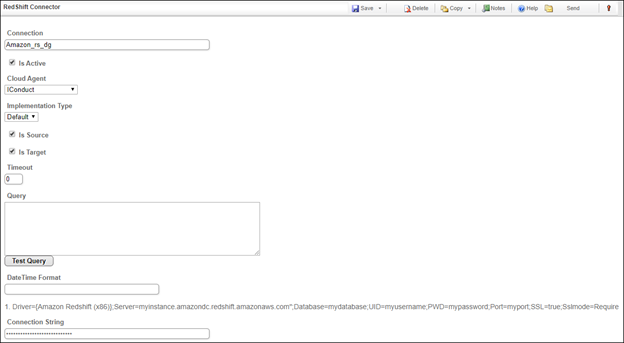Amazon Redshift
Amazon Redshift is a fully managed, petabyte-scale data warehouse service in the cloud. The service is designed for large scale data set storage and analysis. It is also used to perform large scale database migrations.
The Amazon RedShift connector by IConduct enables you to organize a seamless data flow between Amazon Redshift and your business applications.
To configure the Amazon RedShift connector, follow the instructions below:
- In the Admin Navigation tree, select Connections and click New.
Connections Section in the Admin Navigation Tree
- Scroll down to the Database Servers section and select the Amazon RedShift item from the list.
 Connector Selection Page
Connector Selection Page
- In the RedShift Connector work area, fill in the following fields and click Save.
 Connection Work Area
Connection Work Area
| Field | Description |
|---|---|
|
Connection* |
A new connection name. Enter a connection alias here. |
|
Is Active |
Toggles connector’s activity at interface execution. Enable the checkbox to activate the connection for execution. |
|
Cloud Agent* |
The LAN you are working with. Select "IConduct" for cloud systems and your corporate agent for internal systems. |
|
Implementation Type* |
Defines the implementation type. Select from the drop-down list:
|
|
Is Source |
This connection entity is available as a data source for Import (writing to Schema). Enable the checkbox to ensure data import. |
|
Is Target |
This connection entity is available as a data target that receives data from schema to current data container. Enable the checkbox to ensure data export. |
|
Timeout |
The length of time (in milliseconds) the IConduct platform waits for a response from the connection provider before returning a timeout error. Set the time value to stop the system from connection attempts. |
|
Query |
The box is intended for entering a query. You can test the defined query by clicking Test Query once the connection is saved. It’s recommended to test the query after the connection testing. |
|
DateTime Format |
Not used in this connector. |
|
Connection String* |
A string that specifies information about a data source and the means of connecting to it. Refer to this page for more information about the Amazon Redshift connection strings. Example:Driver=Amazon Redshift (x64);Server=myinstance.amazondc.redshift.amazonaws.com; database=mydatabase;UID=myusername;PWD=mypassword; Port=myport;SSL=true;Sslmode=Require |
* - mandatory fields
The Connection String includes the following elements:
| Field | Value |
|---|---|
|
Driver |
The name of the ODBC driver setup on IConduct agent. Depending on the driver you download for your architecture, values will be Amazon Redshift (x86) (for the 32-bit driver) or Amazon Redshift (x64) (for the 64-bit driver). |
| Server | The endpoint of the Amazon Redshift cluster. |
| Database | The database that you created for your cluster. |
| UID | The username of a user account that has permission to connect to the database. This value is a database permission, not an Amazon Redshift permission, although you can use the master user account that you set up when you launched the cluster. |
| PWD | The password for the user account to connect to the database. |
| Port | The port number that you specified when you launched the cluster. If you have a firewall, ensure that this port is open for you to use. |
| SSL |
A value that determines whether to use a Secure Socket Layer (SSL) connection. The following values are possible:
Indicate SSL=true for a secure connection. |
| sslMode | A setting that determines how to handle server certificate verification. Indicate Sslmode=Require for a secure connection. |
Once the connection is saved, you can test if it is successful. Click Test Connection in the toolbar. If the created connection works, you will receive a success message.
Testing the Connection
